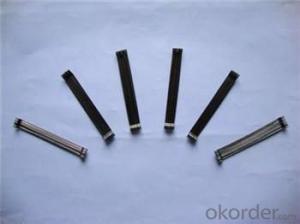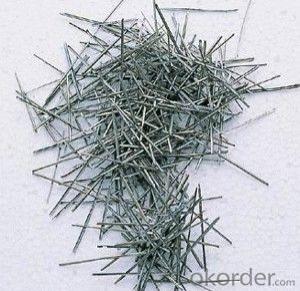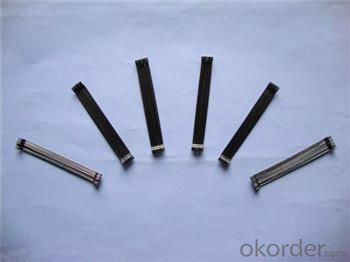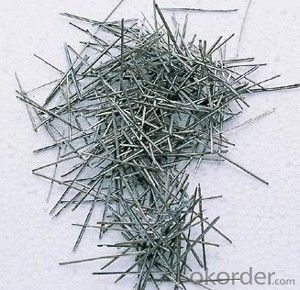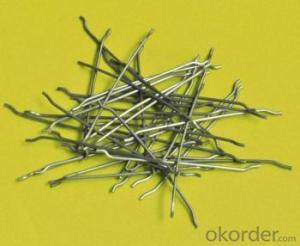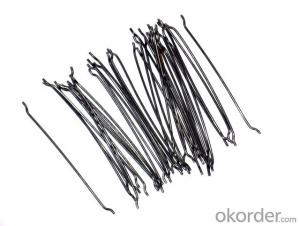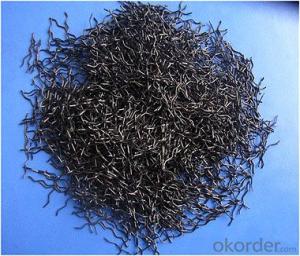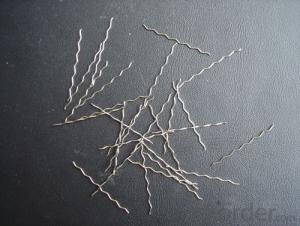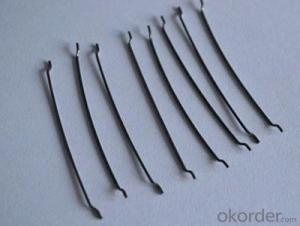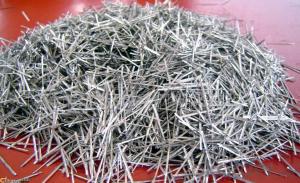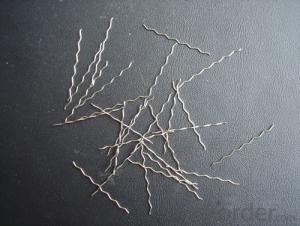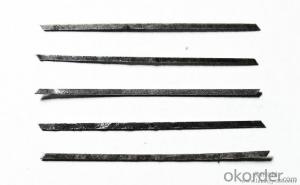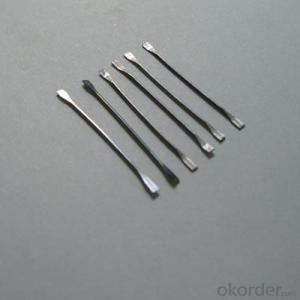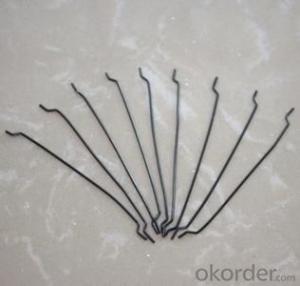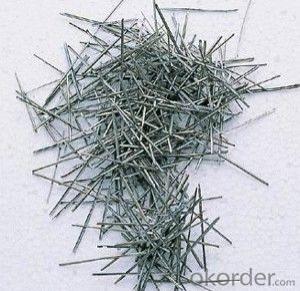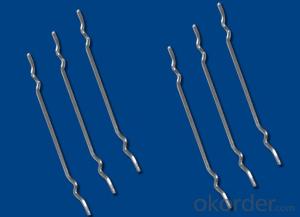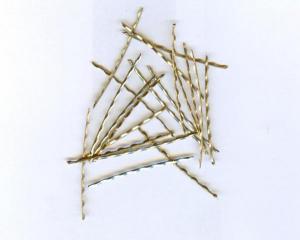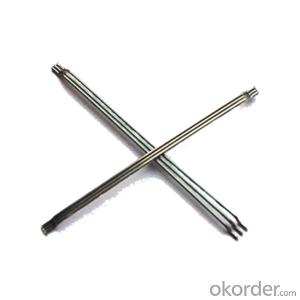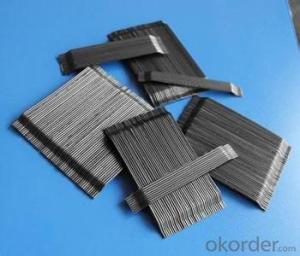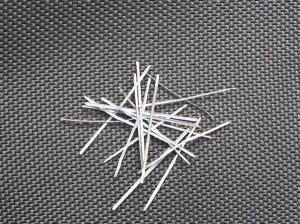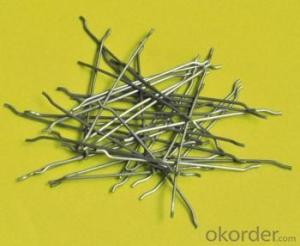Melt Extract Stainless Steel Fiber for Construction and Concrete from China
- Loading Port:
- Tianjin
- Payment Terms:
- TT OR LC
- Min Order Qty:
- 1000 kg
- Supply Capability:
- 250000 kg/month
OKorder Service Pledge
OKorder Financial Service
You Might Also Like
Quick Details
type: steel fiber
usege: concrete of construction
material: steel wire
shape: hooked end,straight middle round fiber
appearance: clear and bright
Place of Origin: Shandong, China (Mainland)
Model Number: hooked steel fiber
Product features
steel fiber for conatruction and concrete reinforcement,widely uesd in concrete to improve its stabality
end hooked steel fiber ,with its high tensile strength ,good scattering and good combination with cenment material
concrete steel fiber is specifically designed to enhance concrete in its hardened state ,the uniform distribution of steel fibers throughout the concrete greatly improve concrete bonding and tensile strengh ,addtionally it provides eceptional load stability and durability ,as reliable and efficient concrete reinforement materisl ,it is widely used in buildings ,bridges,thin roof engineering ,highy way etc.
Specifications
Length :20-60mm
Diameter :0.5-1.2mm
tensile strength :>1100Mpa
type :hooked end ,straight round fiber
appearance : clear and bright
Picture
WAVE STEEL FIBER
HOOK-END STEEL FIBER
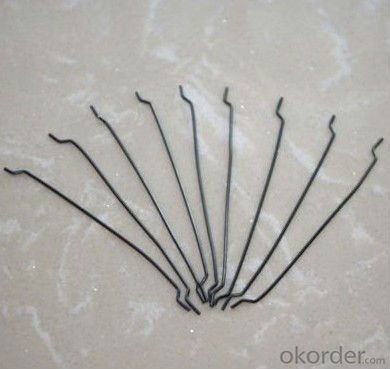
GLUED STEEL FIBER
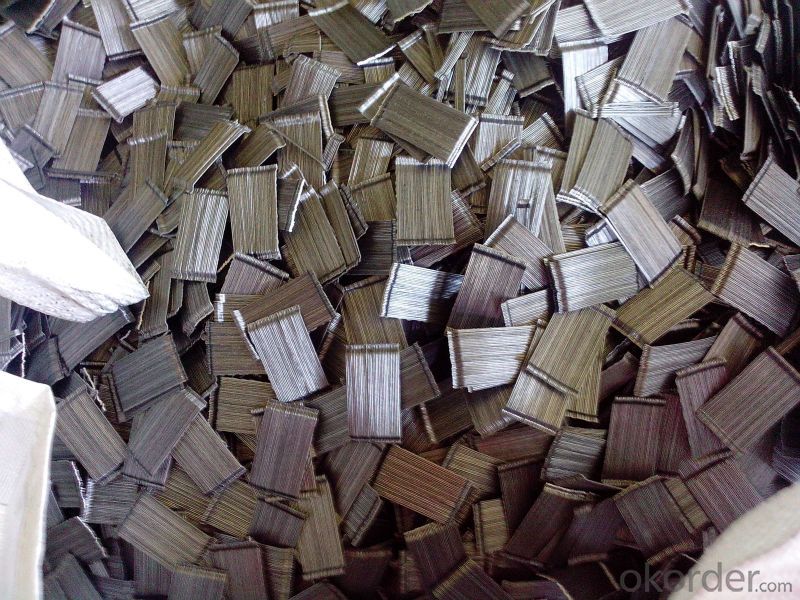
FAQ
we can produce any type steel fiber and of course we can make production according to your requirement
we have specilize in this field for almost 10 years ,with good quality and competitive price
- Q: Can melt extract stainless steel fiber be used in sports field pavements?
- Yes, melt extract stainless steel fiber can be used in sports field pavements. Its high tensile strength and corrosion resistance make it suitable for withstanding the heavy foot traffic and weather conditions typically found in sports fields. Additionally, its durability helps enhance the longevity and performance of the pavement, making it a viable option for such applications.
- Q: Can melt extract stainless steel fiber be used in bridge deck applications?
- Yes, melt extract stainless steel fiber can be used in bridge deck applications. Melt extract stainless steel fiber is a type of reinforcement that is commonly used in concrete structures, including bridge decks. It is known for its high tensile strength, corrosion resistance, and durability, making it an ideal choice for applications where the structure is exposed to harsh environmental conditions, such as bridges. The stainless steel fibers are typically added to the concrete mixture, providing additional strength and crack resistance to the bridge deck. Additionally, melt extract stainless steel fiber can help improve the overall performance and lifespan of the bridge deck by reducing shrinkage, minimizing cracking, and enhancing structural integrity. Therefore, it is a suitable and commonly used reinforcement material for bridge deck applications.
- Q: What is the effect of melt extract stainless steel fiber on the drying time of concrete?
- The use of melt extract stainless steel fiber in concrete can significantly reduce the drying time. The fibers help to enhance the drying process by improving the overall strength and durability of the concrete mixture. This, in turn, allows for faster evaporation of moisture, resulting in a shorter drying time for the concrete.
- Q: Can melt extract stainless steel fiber be used in self-compacting concrete applications?
- Yes, melt extract stainless steel fiber can be used in self-compacting concrete applications.
- Q: How does melt extract stainless steel fiber affect the resistance of concrete to sulfate attack?
- Melt extract stainless steel fiber has a positive impact on the resistance of concrete to sulfate attack. Sulfate attack occurs when sulfate ions present in soil or water react with certain compounds in concrete, leading to the formation of expansive products that can cause concrete deterioration. Stainless steel fibers, when added to concrete, act as a reinforcement material that enhances its overall durability and resistance to various forms of degradation, including sulfate attack. The presence of these fibers helps to improve the concrete's ability to resist the penetration of sulfate ions and minimize the formation of harmful expansive products. The melt extraction process used to produce stainless steel fibers ensures a high level of purity and a uniform distribution within the concrete matrix. This results in improved bonding between the fibers and the surrounding concrete, creating a stronger and more resistant material. Furthermore, the corrosion-resistant properties of stainless steel fibers make them particularly effective in preventing concrete deterioration caused by sulfate attack. Unlike other types of fibers, stainless steel fibers do not corrode when exposed to sulfate ions. This corrosion resistance helps to maintain the integrity of the concrete and prevents the formation of cracks or other forms of damage that can occur due to the expansion of sulfate products. In conclusion, the addition of melt extract stainless steel fiber to concrete enhances its resistance to sulfate attack by improving its ability to withstand the penetration of sulfate ions and minimizing the formation of expansive products. The corrosion-resistant properties of stainless steel fibers further contribute to the long-term durability and performance of concrete in sulfate-rich environments.
- Q: How does melt extract stainless steel fiber improve the resistance to spalling in concrete?
- The addition of melt extract stainless steel fibers to concrete enhances its resistance to spalling by reinforcing and increasing its overall durability. These stainless steel fibers disperse evenly throughout the concrete, creating a three-dimensional network that acts as reinforcement. This reinforcement improves the concrete's tensile strength and crack resistance. Spalling, which is the chipping, flaking, or peeling off of the concrete surface, can occur due to freeze-thaw cycles, high temperatures, or chemical exposure. However, the inclusion of melt extract stainless steel fibers helps prevent cracks from spreading and reduces the expansion and contraction of the concrete, mitigating these effects. The high tensile strength of stainless steel fibers allows them to absorb and distribute stress in the concrete, preventing crack formation and minimizing the impact of external forces. Additionally, the corrosion-resistant properties of stainless steel ensure the fibers remain intact and do not deteriorate over time, providing long-term reinforcement. Furthermore, the three-dimensional network formed by the stainless steel fibers helps bridge any cracks that may develop in the concrete. This bridging effect prevents the cracks from widening and propagating, significantly reducing the likelihood of spalling. In conclusion, melt extract stainless steel fiber improves concrete's resistance to spalling by reinforcing the material, increasing its tensile strength, reducing crack propagation, and enhancing its overall durability. By incorporating these fibers into the concrete mix, the risk of spalling due to freeze-thaw cycles, high temperatures, or chemical exposure is greatly minimized, resulting in a more resilient and long-lasting concrete structure.
- Q: How does the addition of melt extract stainless steel fiber affect the drying time of concrete?
- The addition of melt extract stainless steel fiber can have a significant impact on the drying time of concrete. Stainless steel fibers are typically added to concrete mixtures to enhance its mechanical properties and improve its durability. One of the key advantages of using stainless steel fibers is their ability to reduce drying shrinkage. Concrete typically undergoes shrinkage as it dries, which can lead to cracks and other structural issues. The addition of stainless steel fibers helps to restrain this shrinkage, resulting in a more controlled and uniform drying process. The presence of stainless steel fibers also aids in the formation of a more interconnected network within the concrete matrix. This network enhances the concrete's resistance to cracking and improves its overall strength. As a result, the concrete can withstand forces and stresses better, even during the drying phase. Furthermore, stainless steel fibers also contribute to the reduction of plastic shrinkage cracking. This type of cracking occurs during the early stages of concrete drying, when the surface moisture evaporates faster than it can be replaced. By reinforcing the concrete, the stainless steel fibers help to mitigate this cracking, leading to a more efficient and stable drying process. In summary, the addition of melt extract stainless steel fiber can significantly affect the drying time of concrete. By reducing drying shrinkage, enhancing the concrete's mechanical properties, and mitigating cracking, the fibers contribute to a more controlled and efficient drying process, ultimately improving the overall performance and durability of the concrete structure.
- Q: What is the effect of melt extract stainless steel fiber on the modulus of rupture of concrete?
- The effect of melt extract stainless steel fiber on the modulus of rupture of concrete is generally positive. When stainless steel fibers are added to concrete, they enhance its tensile strength and ductility, leading to an increase in the modulus of rupture. This is because stainless steel fibers act as reinforcement within the concrete matrix, effectively bridging cracks and preventing their propagation. As a result, the concrete becomes more resistant to cracking and can withstand higher levels of stress before failure. The addition of melt extract stainless steel fibers also improves the overall durability and long-term performance of concrete. These fibers are resistant to corrosion, which is a common issue in concrete structures exposed to harsh environments or in contact with chemicals. By providing an additional layer of protection against corrosion, stainless steel fibers help to maintain the structural integrity and extend the service life of concrete. Furthermore, melt extract stainless steel fibers can enhance the impact resistance and fatigue strength of concrete. The fibers absorb and distribute energy during dynamic loading, reducing the risk of sudden failure or damage caused by impact or cyclic loading. This is particularly important in applications where the concrete is subjected to heavy loads or dynamic forces, such as in industrial floors, bridge decks, or pavements. It is worth noting that the specific effect of melt extract stainless steel fiber on the modulus of rupture can vary depending on factors such as fiber content, aspect ratio, and distribution within the concrete mix. Therefore, it is important to carefully consider the design and dosage of stainless steel fibers to achieve the desired improvement in the modulus of rupture and other mechanical properties of concrete.
- Q: Can melt extract stainless steel fiber be used in lightweight aggregate concrete wall panels?
- Yes, melt extract stainless steel fiber can be used in lightweight aggregate concrete wall panels. Stainless steel fibers are commonly used as reinforcement in concrete to enhance its tensile strength, crack resistance, and durability. Lightweight aggregate concrete, which is made by replacing traditional coarse aggregate with lightweight materials such as expanded clay or shale, offers several advantages including lower dead load, better thermal insulation, and improved fire resistance. By incorporating melt extract stainless steel fibers into lightweight aggregate concrete, the resulting wall panels can benefit from the additional reinforcement provided by the fibers. This reinforcement helps to prevent cracking and improve the overall structural integrity of the panels. Additionally, stainless steel fibers are corrosion-resistant, which is crucial for applications in concrete exposed to harsh environments or moisture. The use of melt extract stainless steel fibers in lightweight aggregate concrete wall panels can also enhance their resistance to impact and blast loads, making them suitable for applications in areas prone to earthquakes or explosions. Furthermore, the addition of stainless steel fibers can improve the ductility and flexural strength of the panels, allowing them to better withstand external forces and deformations. Overall, melt extract stainless steel fibers can be successfully used in lightweight aggregate concrete wall panels to enhance their mechanical properties, durability, and performance in various applications.
- Q: What are the advantages of melt extract stainless steel fiber over other types of steel fibers?
- Melt extract stainless steel fibers provide numerous benefits compared to other varieties of steel fibers. To begin with, the corrosion resistance of melt extract stainless steel fibers is exceptional. The fibers contain a significant amount of chromium, which produces a protective oxide layer on their surface. This layer acts as a barrier against corrosive elements, ensuring high resistance to rust and deterioration. This advantage is particularly crucial in environments where exposure to moisture, chemicals, or elevated temperatures is common. Furthermore, the mechanical properties of melt extract stainless steel fibers surpass those of other steel fibers. These fibers are manufactured by melting the steel and subsequently rapidly extracting it into fine filaments. This process results in fibers with a high tensile strength, enabling them to withstand heavy loads and resist deformation under stress. This strength also enhances the durability and lifespan of structures reinforced with melt extract stainless steel fibers. Moreover, melt extract stainless steel fibers possess a high melting point, rendering them suitable for use in high-temperature applications. These fibers can endure extreme heat without compromising their structural integrity, making them ideal for reinforcing concrete in settings such as industrial furnaces, fire-resistant structures, and thermal power plants. Additionally, the fine and uniform nature of melt extract stainless steel fibers allows for better dispersion throughout the concrete matrix. This leads to enhanced crack resistance and improved load-bearing capacity of the reinforced concrete. The small diameter of these fibers also facilitates superior bonding with the surrounding concrete, resulting in increased bond strength and overall structural performance. Finally, melt extract stainless steel fibers exhibit excellent electrical conductivity. This makes them appropriate for applications requiring electrical grounding or conductivity, like electromagnetic shielding or structures exposed to electrical currents. In conclusion, melt extract stainless steel fibers offer a multitude of advantages, including superior corrosion resistance, high mechanical strength, resistance to high temperatures, improved crack resistance, enhanced bond strength, and excellent electrical conductivity. These factors establish them as the preferred choice over other steel fibers for a wide range of applications in the construction, infrastructure, and industrial sectors.
Send your message to us
Melt Extract Stainless Steel Fiber for Construction and Concrete from China
- Loading Port:
- Tianjin
- Payment Terms:
- TT OR LC
- Min Order Qty:
- 1000 kg
- Supply Capability:
- 250000 kg/month
OKorder Service Pledge
OKorder Financial Service
Similar products
Hot products
Hot Searches
Related keywords
